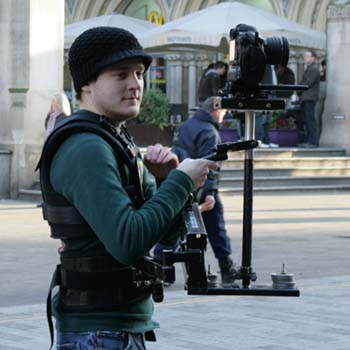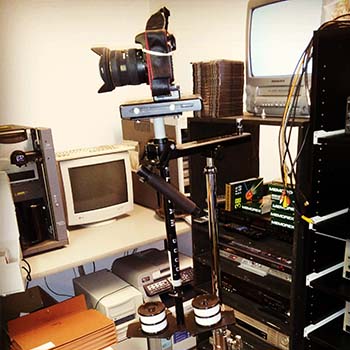Old school Glidecam V-20 at work!
A steadicam is a mounted video camera that allows for the taking of unshaken andmore stable footage without using complicated dollies or tracks. It prevents the unavoidable hand shakes from even the most talented camera operators during fast-paced shots or filming that requires a fluid movement on the part of the camera operator. Essentially, it’s a harness that attaches the camera to the operator, or a camera that is attached to a a bar with a handle. This bar differs from a standard tripod as is allows for much swifter movement.
Several notable scenes in famous films have employed a steady cam, including when Danny rides his tricycle around the hotel in The Shining, as well as countless other films and television shows that have used long, uninterrupted single-camera shots.
[text-box width=”100%” align=”center”]
Learn About Our Rental Gear!
Get 10% off by clicking below to learn more.
[/text-box]
Whether for commercial video production, educational video production, marketing video production or online video production, a steadicam can incorporate a more professional tone as well as a creative effect for nearly all forms of video production.
 Here are some tips for operating a steadicam:
Here are some tips for operating a steadicam:
• Protection: steadicam differ in size and complexity from regular cameras. In inclement weather, they need protection like any other lens but this can be difficult because handling a tarp can become cumbersome while holding onto the camera. A well-fitted harness will prevent wind from affecting the stability of the camera, and shields will protect from rain if using a tarp is too difficult. The shield should be attached in the direction of the wind, and this is especially helpful during event video production, where the venue is not changeable despite the weather.
• Planning: conduct a few walkthroughs of scenes with the steadicam to best determine the appropriate angles and how the footage will look in the end. By planning out where everything will be, no one involved in the project will be tripping over each other and the footage will be as smooth as possible. In addition to the above, having a colleague guide you so you don’t trip over or bump into anything while walking backwards will allow the camera operator to focus on the shot itself and not be distracted by their surroundings.
• Practice: operating a steadicam is often likened to ballroom dancing with regards to the precise and delicate footwork involved. Because your body is controlling much of the camera, practice walking around with your hands behind your back and focus on the movement of the rest of your body. This will give you a better understanding of how your movement affects the shot.
• Study: study your own shots and other shots that use steadicams. Pan around an area and have an actor walk into the shot once in a while. Watching other films that make use of steadicams will help you gain some insight into how they are used, and E-bay and Amazon are full of DVDs and books that teach effective steadicam operation for all forms of video production. Many cities also have courses and workshops that can help you hone your budding filmmaker skills.
 • Balancing: balancing is potentially the most important aspect of operating a steadicam, and a properly balanced steadicam allows for more precise operation. Because the steadicam is a heavy object on top of a tall pole, the weight of the camera may pose problems and the unit as a whole must be properly balanced. The “pole” is called a sled, and the handle that slides up and down the sled is called the gimbal. When the gimbal is moved higher or lower, it changes the speed at which the camera moves forward and backward. The weight of the camera combined with the weights of the monitor and battery pack at the base of the sled (which looks like an upside down “T”, with the battery and monitor at opposite ends of the smaller line on the “T”) can affect how balanced it is and may require some adjustments.
• Balancing: balancing is potentially the most important aspect of operating a steadicam, and a properly balanced steadicam allows for more precise operation. Because the steadicam is a heavy object on top of a tall pole, the weight of the camera may pose problems and the unit as a whole must be properly balanced. The “pole” is called a sled, and the handle that slides up and down the sled is called the gimbal. When the gimbal is moved higher or lower, it changes the speed at which the camera moves forward and backward. The weight of the camera combined with the weights of the monitor and battery pack at the base of the sled (which looks like an upside down “T”, with the battery and monitor at opposite ends of the smaller line on the “T”) can affect how balanced it is and may require some adjustments.
Additionally, small weights called “pilots” can be screwed on at different ends of the sled to help balance it more.
For further reading on static balancing, dynamic balancing and the formulas for both, check out this link.
